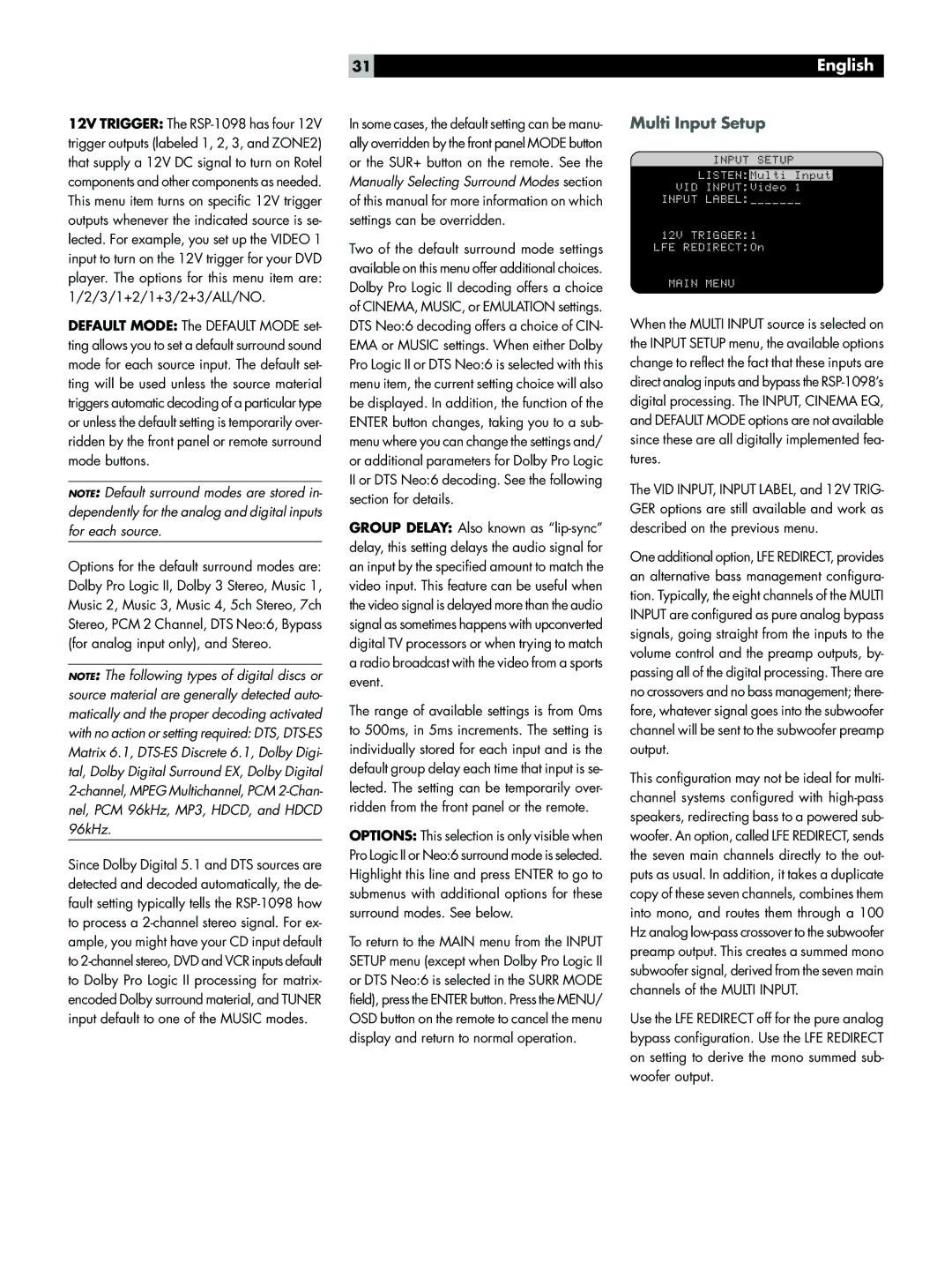12V TRIGGER: The RSP-1098 has four 12V trigger outputs (labeled 1, 2, 3, and ZONE2) that supply a 12V DC signal to turn on Rotel components and other components as needed. This menu item turns on specific 12V trigger outputs whenever the indicated source is se- lected. For example, you set up the VIDEO 1 input to turn on the 12V trigger for your DVD player. The options for this menu item are: 1/2/3/1+2/1+3/2+3/ALL/NO.
DEFAULT MODE: The DEFAULT MODE set- ting allows you to set a default surround sound mode for each source input. The default set- ting will be used unless the source material triggers automatic decoding of a particular type or unless the default setting is temporarily over- ridden by the front panel or remote surround mode buttons.
NOTE: Default surround modes are stored in- dependently for the analog and digital inputs for each source.
Options for the default surround modes are: Dolby Pro Logic II, Dolby 3 Stereo, Music 1, Music 2, Music 3, Music 4, 5ch Stereo, 7ch Stereo, PCM 2 Channel, DTS Neo:6, Bypass (for analog input only), and Stereo.
NOTE: The following types of digital discs or source material are generally detected auto- matically and the proper decoding activated with no action or setting required: DTS, DTS-ES Matrix 6.1, DTS-ES Discrete 6.1, Dolby Digi- tal, Dolby Digital Surround EX, Dolby Digital 2-channel, MPEG Multichannel, PCM 2-Chan- nel, PCM 96kHz, MP3, HDCD, and HDCD 96kHz.
Since Dolby Digital 5.1 and DTS sources are detected and decoded automatically, the de- fault setting typically tells the RSP-1098 how to process a 2-channel stereo signal. For ex- ample, you might have your CD input default to 2-channel stereo, DVD and VCR inputs default to Dolby Pro Logic II processing for matrix- encoded Dolby surround material, and TUNER input default to one of the MUSIC modes.
In some cases, the default setting can be manu- ally overridden by the front panel MODE button or the SUR+ button on the remote. See the Manually Selecting Surround Modes section of this manual for more information on which settings can be overridden.
Two of the default surround mode settings available on this menu offer additional choices. Dolby Pro Logic II decoding offers a choice of CINEMA, MUSIC, or EMULATION settings. DTS Neo:6 decoding offers a choice of CIN- EMA or MUSIC settings. When either Dolby Pro Logic II or DTS Neo:6 is selected with this menu item, the current setting choice will also be displayed. In addition, the function of the ENTER button changes, taking you to a sub- menu where you can change the settings and/ or additional parameters for Dolby Pro Logic
IIor DTS Neo:6 decoding. See the following section for details.
GROUP DELAY: Also known as “lip-sync” delay, this setting delays the audio signal for an input by the specified amount to match the video input. This feature can be useful when the video signal is delayed more than the audio signal as sometimes happens with upconverted digital TV processors or when trying to match a radio broadcast with the video from a sports event.
The range of available settings is from 0ms to 500ms, in 5ms increments. The setting is individually stored for each input and is the default group delay each time that input is se- lected. The setting can be temporarily over- ridden from the front panel or the remote.
OPTIONS: This selection is only visible when Pro Logic II or Neo:6 surround mode is selected. Highlight this line and press ENTER to go to submenus with additional options for these surround modes. See below.
To return to the MAIN menu from the INPUT SETUP menu (except when Dolby Pro Logic II or DTS Neo:6 is selected in the SURR MODE field), press the ENTER button. Press the MENU/ OSD button on the remote to cancel the menu display and return to normal operation.
Multi Input Setup
INPUT SETUP
LISTEN:Multi Input
VID INPUT:Video 1
INPUT LABEL:_______
12V TRIGGER:1
LFE REDIRECT:On
MAIN MENU
When the MULTI INPUT source is selected on the INPUT SETUP menu, the available options change to reflect the fact that these inputs are direct analog inputs and bypass the RSP-1098’s digital processing. The INPUT, CINEMA EQ, and DEFAULT MODE options are not available since these are all digitally implemented fea- tures.
The VID INPUT, INPUT LABEL, and 12V TRIG- GER options are still available and work as described on the previous menu.
One additional option, LFE REDIRECT, provides an alternative bass management configura- tion. Typically, the eight channels of the MULTI INPUT are configured as pure analog bypass signals, going straight from the inputs to the volume control and the preamp outputs, by- passing all of the digital processing. There are no crossovers and no bass management; there- fore, whatever signal goes into the subwoofer channel will be sent to the subwoofer preamp output.
This configuration may not be ideal for multi- channel systems configured with high-pass speakers, redirecting bass to a powered sub- woofer. An option, called LFE REDIRECT, sends the seven main channels directly to the out- puts as usual. In addition, it takes a duplicate copy of these seven channels, combines them into mono, and routes them through a 100 Hz analog low-pass crossover to the subwoofer preamp output. This creates a summed mono subwoofer signal, derived from the seven main channels of the MULTI INPUT.
Use the LFE REDIRECT off for the pure analog bypass configuration. Use the LFE REDIRECT on setting to derive the mono summed sub- woofer output.

